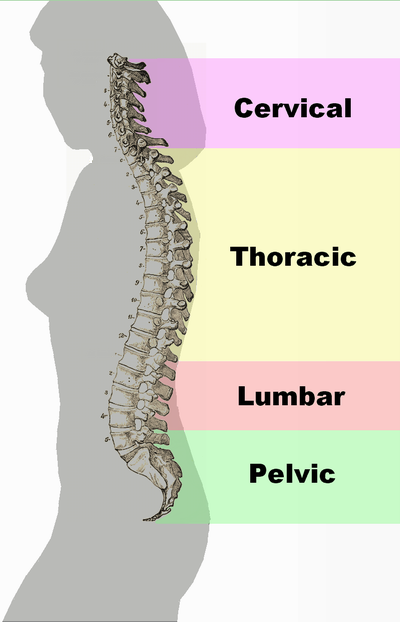Back pain
For patient information click here
| Back pain | |
 | |
|---|---|
| Different regions (curvatures) of the vertebral column | |
| ICD-10 | M54 |
| ICD-9 | 724.5 |
| DiseasesDB | 15544 |
| MeSH | D001416 |
|
Back pain Microchapters |
|
Diagnosis |
|---|
|
Treatment |
|
Lecture |
|
Case Studies |
|
Back pain On the Web |
|
American Roentgen Ray Society Images of Back pain |
Editor-In-Chief: C. Michael Gibson, M.S., M.D. [1]; Robert G. Schwartz, M.D. [2], Piedmont Physical Medicine and Rehabilitation, P.A.; Associate Editor-In-Chief: Cafer Zorkun, M.D., Ph.D. [3], M.Umer Tariq [4]
Synonyms and keywords: Lumbago; backache; dorsalgia
Underlying causes
Transient back pain is likely one of the first symptoms of influenza.
Muscle strains (pulled muscles) are commonly identified as the cause of back pain, as are muscle imbalances. Pain from such an injury often remains as long as the muscle imbalances persist. The muscle imbalances cause a mechanical problem with the skeleton, building up pressure at points along the spine, which causes the pain. Ligament strain is a very common cause of back pain as well [5].
Another cause of acute low back pain is a Meniscoid Occlusion. The more mobile regions of the spine have invaginations of the synovial membrane that act as a cushion to help the bones move over each other smoothly. The synovial membrane is well supplied with blood and nerves. When it becomes pinched or trapped it can cause sudden severe pain. The pinching causes the membrane to become inflamed, causing greater pressure and ongoing pain. Symptoms include severe low back pain that may be accompanied by muscle spasm, pain with walking, concentration of pain to one side, and no radiculopathy (radiating pain down buttock and leg). Relief should be felt with flexion (bending forward),and exacerbated with extension (bending backward).
When back pain lasts more than three months, or if there is more radicular pain (sciatica) than back pain, a more specific diagnosis can usually be made. There are several common causes of back pain: for adults under age 50, these include ligament strain, nerve root irritation, spinal disc herniation and degenerative disc disease or isthmic spondylolisthesis; in adults over age 50, common causes also include osteoarthritis (degenerative joint disease) and spinal stenosis [6],trauma, cancer, infection, fractures, and inflammatory disease [7]. Non-anatomical factors can also contribute to or cause back pain, such as stress, repressed anger,[8] or depression. Even if there is an anatomical cause for the pain, if depression is present it should also be treated concurrently.
New attention has been focused on non-discogenic back pain, where patients have normal or near-normal MRI and CT scans. One of the newer investigations looks into the role of the dorsal ramus in patient's pain that have normal radiographic evidence. See Posterior Rami Syndrome. Diagnostic musculoskeletal ultrasonography has been shown to be helpful in objectifying multifidus atropy.
Back Pain During Pregnancy
About 50% of women experience low back pain during pregnancy.[1]
Back pain in pregnancy may be severe enough to cause significant pain and disability and pre-dispose patients to back pain in a following pregnancy. No significant increased risk of back pain with pregnancy has been found with respect to maternal weight gain, exercise, work satisfaction, or pregnancy outcome factors such as birth weight, birth length, and Apgar scores.
Biomechanical factors of pregnancy that are shown to be associated with low back pain of pregnancy include abdominal sagittal and transverse diameter and the depth of lumbar lordosis. Typical factors aggravating the back pain of pregnancy include standing, sitting, forward bending, lifting, and walking. Back pain in pregnancy may also be characterized by pain radiating into the thigh and buttocks, night-time pain severe enough to wake the patient, pain that is increased during the night-time, or pain that is increased during the day-time.
The avoidance of high impact, weight-bearing activities and especially those that asymmetrically load the involved structures such as: extensive twisting with lifting, single-leg stance postures, stair climbing, and repetitive motions at or near the end-ranges of back or hip motion can ease the pain.
Direct bending to the ground without bending the knee causes severe impact on the lower back in pregnancy and in normal individuals, which leads to strain, especially in the lumbo-saccral region that in turn strains the multifidus.
See also
- Failed back syndrome
- Low back pain
- Posterior Rami Syndrome
- Tension myositis syndrome
- Upper back pain
- Pregnancy related pelvic girdle pain
References
- ↑ Ostgaard HC, Andersson GBJ, Karlsson K. Prevalence of back pain in pregnancy. Spine 1991;16:549-52.
External links
- Back Pain - Information for Patients
- Back pain at the Open Directory Project
- Template:NINDS
- Handout on Health: Back Pain at National Institute of Arthritis and Musculoskeletal and Skin Diseases
- Back Pain Information for Patients: Spine-health.com
- Patient's guide to back pain
- Back pain, on Medline plus, a service of the National Library of Medicine
Template:Diseases of the musculoskeletal system and connective tissue
de:Rückenschmerzen it:Dorsopatia nl:Rugpijn simple:back pain